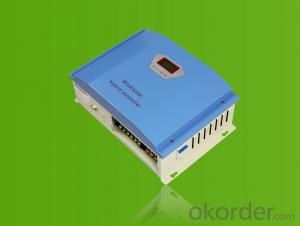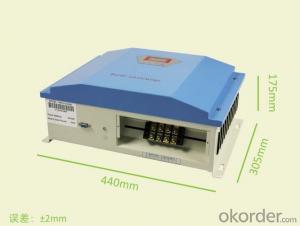PWM Solar Charge Controller,20A 12/24V,LS2024B
OKorder Service Pledge
OKorder Financial Service
You Might Also Like
Descriptions:
A charge controller, or charge regulator is basically a voltage and/or current regulator to keep batteries from overcharging. It regulates the voltage and current coming from the solar panels going to the battery. Most "12 volt" panels put out about 16 to 20 volts, so if there is no regulation the batteries will be damaged from overcharging. Most batteries need around 14 to 14.5 volts to get fully charged.
Features:
·High efficiency PWM charging with temperature compensation
·3 LEDs shows PV charging, battery and load status
·External temperature sensor interface
·RS-485 bus communication
·Open standard Modbus communication protocol
·Software update function
·Diversified load control modes : Manual, Light ON/OFF, Light ON+ Timer, Time Control
·Battery type selection: Gel, sealed, flooded and User type
·Real-time monitor
·Programmable parameters
·LVD or SOC load disconnect function
·Energy statistics function
Electronic Protections:
·PV short circuit
·PV reverse polarity
·Battery overcharge
·Battery over discharge
·Battery reverse polarity
·Load short circuit
·Load overload
·Overheating
Specification:
Electrical parameters | LS1024B | LS2024B | LS3024B |
Nominal System Voltage | 12 / 24V auto work | ||
Rated Battery Current | 10A | 20A | 30A |
Maximum battery voltage | 50V | ||
Grounding | Common positive | ||
Self-consumption | 8.4mA(12V),7.8mA(24V) | ||
Temp. compensation | -3mV/℃/2V(25℃ ref) | ||
Equalize charging voltage | Sealed: 14.6V, Flooded: 14.8V, User-defined: 9~17V | ||
Boost charging voltage | Gel: 14.2V, Sealed: 14.4V, Flooded: 14.6V, User-defined: 9~17V | ||
Float charging voltage | Gel /Sealed /Flooded: 13.8V, User-defined: 9~17V | ||
Low voltage reconnect voltage | Gel /Sealed /Flooded: 12.6V, User-defined: 9~17V | ||
Low voltage disconnect voltage | Gel /Sealed /Flooded: 11.1V, User-defined: 9~17V | ||
Working temp. | -35℃~+55℃ | ||
Humidity | ≤95% (NC) | ||
Enclosure | IP30 | ||
Dimension | 138.6x69.3x37mm | 159.6x81.4x47.8mm | 200.6x101.3x57mm |
Terminal | 4mm2 | 10mm2 | 10mm2 |
Net weight | 0.13kg | 0.3kg | 0.5kg |



- Q: Is a solar controller necessary for grid-tied solar systems?
- No, a solar controller is not necessary for grid-tied solar systems. Grid-tied systems are connected to the utility grid and do not require batteries to store excess energy. Therefore, a solar controller, which regulates the charging and discharging of batteries, is not needed in this type of system.
- Q: Can a solar controller be used with solar panel sun tracking systems?
- Yes, a solar controller can be used with solar panel sun tracking systems. A solar controller is designed to regulate the voltage and current from the solar panels to ensure proper charging of batteries or powering of electrical devices. It monitors the input from the solar panels and adjusts the output accordingly to maximize efficiency and protect the system from overcharging or overloading. In the case of solar panel sun tracking systems, the solar controller plays a crucial role in managing the power generated by the panels. Sun tracking systems use sensors and motors to adjust the position of the solar panels throughout the day, ensuring they are always facing the sun for maximum sunlight exposure. This means that the output voltage and current from the panels can vary depending on their positioning. The solar controller will take into account these variations and optimize the charging or power supply accordingly. It will continually monitor the input from the solar panels, adjust the charging parameters, and regulate the output to ensure the batteries are charged properly or the electrical devices are powered efficiently. Using a solar controller with solar panel sun tracking systems is highly recommended as it helps to maintain the overall performance and longevity of the system. It ensures that the solar panels are working at their maximum potential, maximizing the energy output and increasing the overall efficiency of the system.
- Q: How does a solar controller prevent overvoltage in the system?
- A solar controller prevents overvoltage in the system by continuously monitoring the voltage output from the solar panels. When the voltage exceeds a predetermined threshold, the controller reduces the charging current, limiting the flow of electricity into the batteries. This effectively prevents overcharging and protects the system from potential damage caused by overvoltage.
- Q: What is the maximum load current for a solar controller?
- The maximum load current for a solar controller depends on the specific model and its specifications. It can range from a few amps to several hundred amps, depending on the capacity and design of the controller.
- Q: How does a solar controller handle variable sunlight conditions?
- A solar controller handles variable sunlight conditions by continuously monitoring the incoming solar energy and adjusting the charging parameters accordingly. It regulates the flow of power from the solar panels to the batteries, ensuring that the batteries are not overcharged or undercharged. This allows the solar controller to maximize the efficiency and lifespan of the batteries, regardless of the changing sunlight intensity.
- Q: Can a solar controller be used with a grid-tied solar system?
- No, a solar controller is not typically used with a grid-tied solar system. Grid-tied systems are designed to directly connect to the electrical grid, allowing excess energy to be fed back into the grid. Solar controllers, on the other hand, are commonly used in off-grid systems to regulate and optimize the charging of batteries.
- Q: Can a solar controller be used with solar-powered fans?
- Yes, a solar controller can be used with solar-powered fans. A solar controller helps regulate and control the flow of electricity from the solar panels to the fans, ensuring optimal performance and preventing any damage to the fans due to overcharging or voltage fluctuations.
- Q: Can a solar controller be used with flexible solar panels?
- Yes, a solar controller can be used with flexible solar panels. Solar controllers are designed to regulate the charging process of solar panels, regardless of their flexibility. As long as the flexible solar panel is compatible with the solar controller's voltage and current ratings, it can be used effectively.
- Q: How does a solar controller handle variations in ambient light conditions?
- A solar controller handles variations in ambient light conditions by continuously monitoring the incoming solar energy and adjusting the charging parameters accordingly. It uses sensors to measure the intensity of light and adjusts the charging current and voltage to optimize the charging efficiency and protect the battery from overcharging or undercharging.
- Q: Does a solar controller have a built-in light sensor?
- Indeed, a solar controller generally incorporates a light sensor within its design. Its primary function is to gauge the strength of sunlight or surrounding light, enabling the solar controller to adapt the charging settings accordingly. This is crucial in order to enhance the charging procedure and safeguard the connected battery from excessive charging or insufficient charging within the solar system. By utilizing the light sensor, the solar controller is able to identify the amount of sunlight accessible and modify the charging current and voltage levels accordingly, thus guaranteeing an effective and secure charging process for the battery.
Send your message to us
PWM Solar Charge Controller,20A 12/24V,LS2024B
OKorder Service Pledge
OKorder Financial Service
Similar products
Hot products
Hot Searches
Related keywords





























